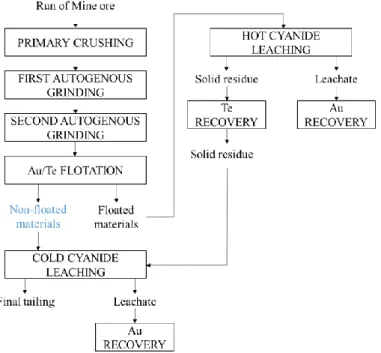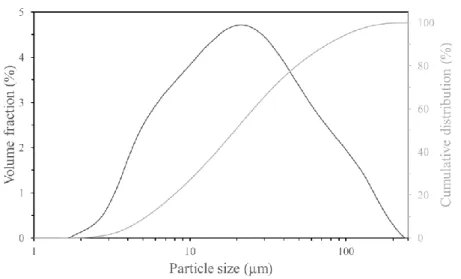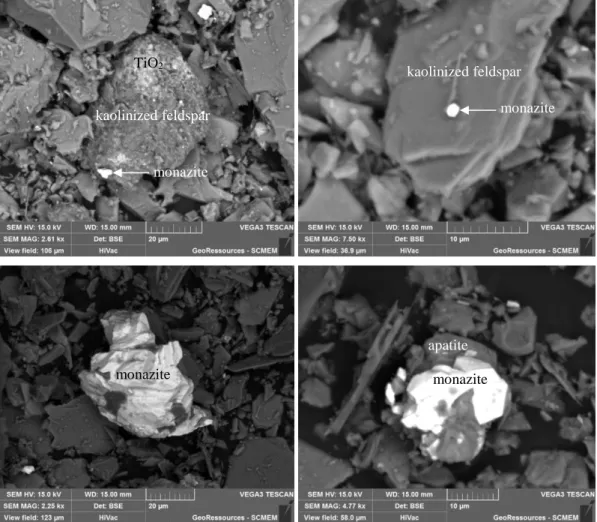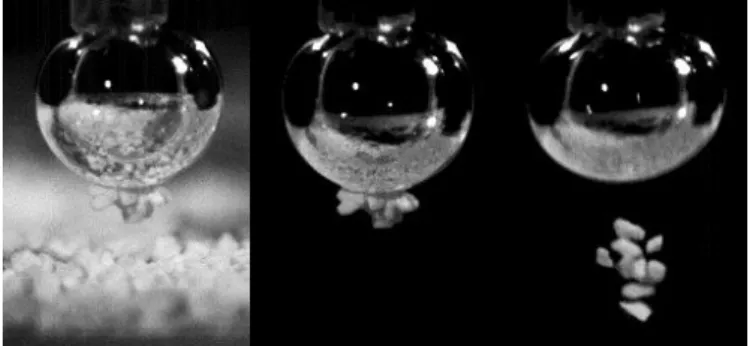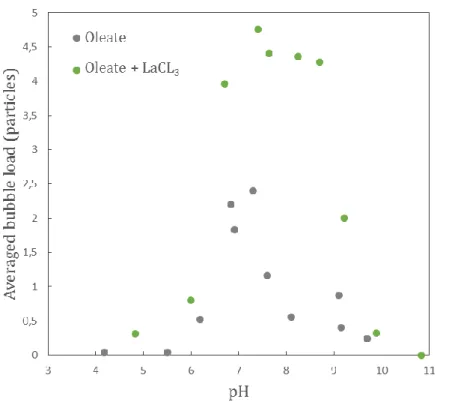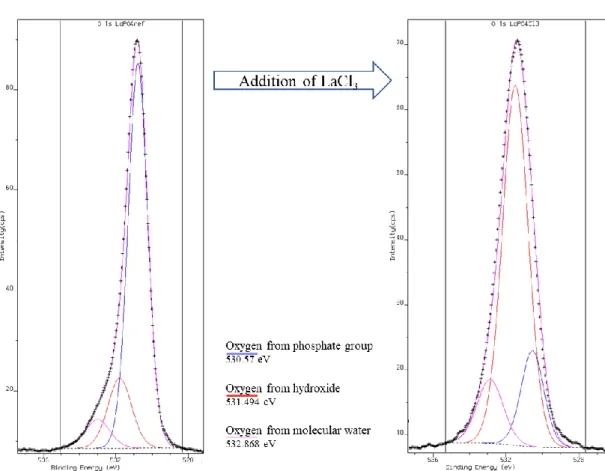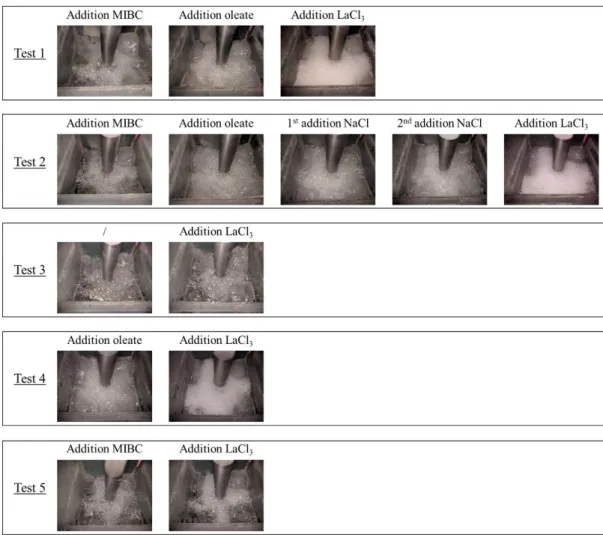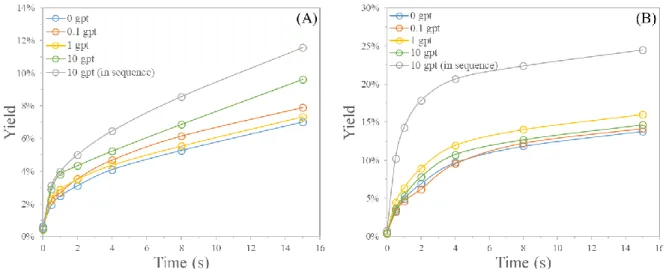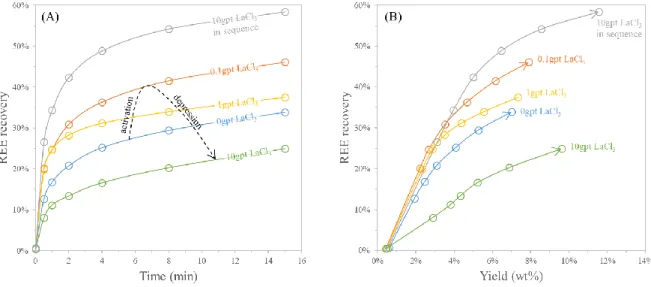HAL Id: hal-02572340
https://hal-brgm.archives-ouvertes.fr/hal-02572340
Submitted on 13 May 2020
HAL is a multi-disciplinary open access
archive for the deposit and dissemination of
sci-entific research documents, whether they are
pub-lished or not. The documents may come from
teaching and research institutions in France or
abroad, or from public or private research centers.
L’archive ouverte pluridisciplinaire HAL, est
destinée au dépôt et à la diffusion de documents
scientifiques de niveau recherche, publiés ou non,
émanant des établissements d’enseignement et de
recherche français ou étrangers, des laboratoires
publics ou privés.
collector adsorption
A Geneyton, L Filippov, Nour-Eddine Menad
To cite this version:
A Geneyton, L Filippov, Nour-Eddine Menad. A new approach in the flotation of monazite using a
lanthanum salt as a catalyzer of the carboxylate collector adsorption. Developments in the Processing
of the ”Hi-Tech” Metals: Hi-Tech Metals ’18, Nov 2018, Cape Town, South Africa. �hal-02572340�
A NEW APPROACH IN THE FLOTATION OF MONAZITE USING A LANTHANUM SALT AS A CATALYZER OF THE CARBOXYLATE COLLECTOR ADSORPTION
A. Geneyton1,2, L.O. Filippov1 and N.E. Menad2
1. Université de Lorraine, CNRS, GeoRessources, F-54000, Nancy, France,
2. D3E/DMP, Bureau de recherche Géologique et Minière (BRGM), 3 avenue Claude Guillemin, 45060, Orléans, France
Corresponding author: lev.filippov@univ-lorraine.fr
ABSTRACT
In this study, we developed a new approach of lanthanum chloride and carboxylate collector combination with the aim of improving the selective and effective collector adsorption onto the rare-earth phosphate minerals. Bubble/particle adhesion tests with sodium oleate collector were performed indicating a higher mineral surface hydrophobicity when using lanthanum chloride.
Flotation experiments were performed with sodium oleate showing enhanced monazite recovery and flotation rate in presence of lanthanum chloride. The best flotation performance was obtained when the lanthanum chloride was added prior to the collector. With regards to the performed XPS study and the literature data, it was suggested that lanthanum ions or lanthanum species strongly interact with the under-coordinated phosphate groups on the monazite surface playing a role of a bridge between the monazite surface and the carboxylate group of the collector. We also observed that the lanthanum chloride dosage and mode of addition must be strictly controlled to avoid a decrease of the availability of the collector and thus a decrease of the monazite recovery and flotation rate.
KEYWORDS
Rare earth minerals, monazite, flotation, lanthanum salts, adsorption, activation, carboxylate, oleate
INTRODUCTION
The affinity of lanthanum for the carboxylate and phosphate groups
Lanthanum ions are known to have a strong affinity for the carboxylate anions and form complexes with the carboxylate ligands [1–4]. Carboxylates and carboxylic acids are studied and commercialized as extractants for rare-earth solvent extraction [5–7] while carboxylic ion-exchange resins are used to entrapped lanthanide elements [8].
Lanthanum ions and lanthanum species are also known to have an excellent phosphate binding capacity. Extensive researches were performed on the removal or on the fixation of phosphates for a multitude of applications including the medical field or the treatment of wastewater and natural water reserves. Soluble lanthanum compounds such as lanthanum chlorides, lanthanum nitrates, and certain lanthanum carboxylate are used as phosphate precipitants [9–11]. In that situation, the phosphate removal required the entrapment of the formed precipitates [10]. This technique is commonly applied for the treatment of aquarium and swimming pools wastewaters although the finely grained precipitate particles are difficult to filtrate. By contrast, sparingly soluble particulate lanthanum carboxylate or non-soluble lanthanum compounds such as lanthanum hydroxides or lanthanum carbonates materials are used as phosphate adsorbents [10]. Beyond the typical water treatment application [12,13], the phosphate sequestering by non-soluble lanthanum materials, notably with oral lanthanum carbonate intakes may be useful for patients suffering from hyperphosphoremia (kidney malfunction) [14]. Lanthanum-modified minerals such as bentonite, kaolinite or zeolites are also studied and commercialized as phosphate removing materials [15–17].
Beyond the use of lanthanum carboxylate as phosphate adsorbents, the double affinity of the lanthanum ions for the carboxylate functional group and the phosphate groups are used to develop new phosphate removal methods. Lanthanum (III) may indeed be immobilized on chelating resins with a dicarboxylate functional group (iminodiacetate functional group of the chelex-100 resin) to produce a polymeric ligand exchanger that efficiently and selectively remove the phosphate anions from the water [18].
From these previous data, it appears that lanthanum carboxylate has a strong phosphate binding capacity. More broadly, lanthanum species are reported to have a strong affinity for both the carboxylates ligands and the phosphates groups. In the case of flotation, only a few studies deal with the effect of the lanthanide salts when carboxylate collectors are used. When using a mixture of tributyl phosphate and saponified waste oil as a collector for the flotation of phosphate from a low-grade tailing, Al-Thyabat and Zhang observed a beneficial effect of the addition of a mixture of cerium compounds, lanthanum compounds and soda ash [19]. This mixture so-called activator was reported to significantly affect the flotation performance. It was shown that an appropriate amount of this activator may significantly improve the phosphate recovery and the selectivity of the collector towards the phosphate minerals. However, the activator dosage must be strictly controlled to avoid detrimental effects on the flotation performance. Lanthanum nitrates are also reported to increase the flotation rate of the rare-earth minerals (monazite and streenstrupine) without any tangible loss of selectivity [20].
Kankberg Au-Te mine
The finely grained sample used in this study were obtained from the tailings of the telluride flotation operations of the Kankberg ore. Kankberg is an Au-Te underground mine in Sweden operational since 2012
and operated by Boliden AB.It is located in the Boliden area in the Skellefte mining district, Sweden. The Boliden area comprises the Renström, Kristineberg and Kankberg underground mines and the Maurliden open-pit mine. All the mines in the Boliden area produce zinc, copper, lead, gold and silver from complex sulphide ores, with the exception of the Kankberg mine which only produces gold and tellurium. The proven mineral reserves of the Kankberg ore body are estimated around 2400 thousand tonnes of ore with an average grade of 3.8 ppm Au, 181 ppm Te.
The extracted ore undergoes different treatment to finally recover the contained gold and tellurium. A simplified bloc-diagram of the gold and tellurium extraction operations is depicted in Figure 1. In a recent research project named ENVIREE, funded from the ERA-MIN European Program, and led by a multidisciplinary consortium, a first assessment of the rare-earth distribution in the flotation tailings of the Kankberg ore was made. It was found that the monazite is present in every size fraction although 62 wt% of the monazite is concentrated in the -20 µm fraction.
Figure 1: Gold and tellurium extractive metallurgy operation Note: The non-floated materials marked in blue were used in this study
MATERIALS AND METHODS
Flotation tailings
A sample of the Au/Te flotation tailings has been received in the form of a pulp with the process water in a hermetically closed barrel. Due to the material compaction, a separation of the water and the solid materials was observed resulting in a nearly dried sample below the water level. The clear process water was removed and the tailings were completely dried at 40 °C for 72 hours, homogenised and split into individual bags of around 480–500 g and stored in a freezer to avoid any further material transformation.
As depicted in Figure 2, this residue is mainly constituted of fine particles (54 wt% in the range of 10–50 µm) and ultrafine particles (27 wt% in the range of 0–10 µm).
Figure 2: Particle size distribution of the flotation residue
X-ray diffraction analyses (XRD) were performed with a Bruker D8-Advance diffractometer equipped with a cobalt anticathode (35 kV–45 mA) as an X-ray emitting source (λ=1.78897 Å), a (theta, 2theta) goniometer, a LynxEye energy-dispersive one-dimensional detector. These analyses highlight that this tailing is mainly constituted of quartz and muscovite with minor amounts of topaz, kaolinite, K-feldspar and andalusite. XRD analyses of some flotation concentrate also highlight the presence of vermiculite, sphalerite, apatite, Bi-Te compounds and monazite.
EDS analyses were also performed and confirm the presence of certain accessory minerals such as topaz, sphalerite, monazite and Bi-Te compounds. It also highlights the presence of FeS and FeS2 compounds, titanium dioxide, and a Fe-Ag-Nb-Te unknown compound (no S detected). Two types of monazites were observed, silica-rich monazites (up to 9 mol% Si) and silica-poor monazites. As illustrated in Figure 3, the monazite minerals were frequently observed in the form of middling particles with apatite or altered potassium alumino-silicates (probably kaolinized K-feldspars), and in inclusion into these latter.
The 40 ICP-MS analyses of the flotation products give a sufficient amount of data to estimate the rare-earth distribution. The percentage of each rare-earth elements (REE) were calculated with a linear regression as illustrated in Figure 4. Table 1 summarizes the obtained rare-earth content and the associated R-squared of the linear regression. The analysis of the feed and the back-calculated feeds also give a value range of 319–345 ppm for the rare-earth content in these flotation tailings.
Table 1: Distribution of the different rare-earth elements based on the ICP-MS analyses
La Ce Pr Nd Sm Eu Gd Tb Dy Ho Er
RE content (wt%) 23.78 46.34 5.38 18.99 2.56 0.52 1.38 0.14 0.60 0.09 0.21
Figure 3: Typical middling grains and encapsulation of the monazite into gangue minerals
Figure 4: Linear regressions of the ratios of certain rare-earth elements
monazite apatite TiO2 monazite kaolinized feldspar monazite monazite kaolinized feldspar
Synthetic monazites
Experiments were performed on sintered cerium and lanthanum hydrated phosphates supplied by Alfa Aesar and identified as rhabdophane analogue using XRD. Compaction into cylindrical pellets was made in a cylindrical press with an 80 kg cm-1 compaction pressure. The cylindrical pellets were put into recrystallized alumina crucibles and thermally treated in an electric muffle furnace. The materials were successively heated at 350 °C, 850 °C, and 1250 °C for 20 minutes. The XRD patterns confirmed a total conversion of the product into dehydrated lanthanum orthophosphate with a monazite structure. Manual crushing with an agate mortar and screening was performed to reduce the pellets to the size range -315 µm + 125 µm desired for the adhesion tests. XPS measurements were performed on synthetic monazite materials pulverized in an agate planetary ball mill (Fritsch Pulverisette) for two hours.
Adhesion tests
The test consists in a series of contact of a still bubble with a mobile particle bed. In absence of mechanical or hydrodynamic perturbations and since the bubble remains perfectly stable, stable adhesion of particles is achieved when the energy of adhesion is sufficient to exceed the weight of the coarse particles (-315 µm + 125 µm) and more importantly the friction with the other particles constituting the particle bed.
Adhesion tests were performed in a solution of 1 x 10-6 mol L-1 oleate previously produced by deprotonation of oleic acid (99 wt% purity supplied by Alfa Aesar) with NaOH in Milli-Q water (18 MΩ.cm) heated to 60 °C. For certain series of adhesion tests, lanthanum chlorides were added in this solution after cooling at 25 °C. 50 mL of the oleate solution was sampled and after pH adjustment using diluted sodium hydroxide or hydrochloric acid, the solution was placed in a test tube containing 100 mg of synthetic monazite grains for 24 hours, a period required to stabilize the system in absence of stirring. During those 24 hours, the pH significantly varies, probably due to the buffer effect of dissolved CO2 and associated species or due to the reaction between the monazite grains and the solution. Typical pH shifts range from 0.1 to 0.3 for initial pH values lower than 5 or higher than 9.5, 0.2 to 0.6 for initial pH values between pH 5 and pH 7.5, and 0.2 to 1 for initial pH values between pH 7.5 and pH 9.5. Since the test tubes were hermetically closed, the system is considered balanced after 24 hours and the state of hydrophobicity of the monazite surface is considered representative of the equilibrium pH. After this period of 24 hours, the particles were extracted with roughly 7 mL of the equilibrated solution and placed in a glass cuvette to form a particle bed. The glass cuvette is then placed on a micro-translation stage. A 1.5 mm bubble was generated and the particles bed was lifted until contact with the bubble. After a contact period of 20 seconds, the particles bed was smoothly moved down and a shock was applied on the bubble holder to detach and count the number of collected grains with a high-speed camera (Figure 5). 25 adhesion attempts were performed for each experimental condition.
Figure 5: Measure of the number of particles collected (bubble load)
XPS
The XPS spectra of the monazite samples were acquired at the LCPME Laboratory (Villers-les-Nancy, France), using a Kratos Axis Ultra DLD (Kratos Analytical, U.K.) X-ray photoelectron spectrometer equipped with a monochromatic Al Kα X-ray source (1486.6 eV) operated at 120 W. Spectra were collected at normal take-off angle (90°) and the analysis area was 700 x 300 µm2. The pressure in the analytical chamber was 10-7 Pa. Survey scans were taken using analyser pass energy of 160 eV and 1 eV steps while high-resolution scans were taken at a pass energy of 20 eV and 0.1 eV steps except for carbon and oxygen (0.05 eV). Charge correction was carried out using the adventitious carbon peak C1s at 284.6 eV.
Sample preparation involved a mixing of 100 mg of a finely grained powder of monazite in 50mL of deionized water for 1 hour in a beaker. The pH was adjusted to the desired value before the monazite addition and maintained constant during the treatment. The particles were then collected by filtration through a nylon filter (0.8 µm pore size) and thoroughly rinsed with deionized water. The powders were then placed in a desiccator under partial vacuum for a few hours before being placed in the analytical chamber
Flotation tests
Flotation tests were conducted in a 1.5 L Agitair flotation cell. The conditioning was performed with a rotor speed of 1000 rpm and a solid content of 60 wt% while the flotation was performed with a rotor speed of 900 rpm, a solid content of 30 wt% and an airflow of 4.5 L min-1. After an attrition of the mineral pulp, sodium silicate was added as a dispersant and silicate depressant. Sodium silicate was directly added in the cell without prior dilution, a dosage of 2850 g t-1 (gram per tonne of ore) of diluted sodium silicate solution was respected (concentrated at 35.1 wt% with a Na2O:SiO2 ratio equal to 0.3:1). MIBC (methyl isobutyl carbinol) was added as a frother with a dosage of 5 g t-1.
A first flotation in the sole presence of the frother was performed for 2 minutes to separate the naturally hydrophobic minerals, mainly sphalerite, iron sulfides and tellurides probably hydrophobized by the residual flotation reagents. It was found that a zinc concentrate (3-4 wt% Zn) may be obtained with a 40 % zinc recovery After this pre-flotation, the lanthanum chloride was whether added two minutes before
the collector solution (sodium oleate) or added with the collector by first mixing them in a beaker for 5 minutes.
Both the conditioning and the flotation were conducted at a pH range of 8.2 to 8.4. In order to limit the influence of the temperature on the flotation performance, the temperature of the tap water added in the flotation cell was stabilized at 25 °C. A reproducible rise in temperature of 4–5 °C was systematically observed and was due to the heat transmitted from the engine to the rotor.
RESULTS
Adhesion tests
In order to see if the presence of soluble lanthanum species influences the adsorption of the carboxylate collector on the rare-earth phosphate, different series of adhesion tests were performed on monazite-(Ce) grains equilibrated with a solution of 1 x 10-6 mol L-1 oleate in presence or absence of LaCl3. Lanthanum chloride was added in the diluted oleate solution. Figure 6 represents the averaged bubble load as a function of the equilibrium pH.
It was shown that the presence of 1 x 10-6 mol L-1 of lanthanum chloride induced a significantly increased adhesion of monazite-(Ce) over a wide range of pH. It is important to notice that under these pH conditions, the bubble surface was frequently saturated by monazite grains (as shown Figure 5 with monazite-Ce conditioned in presence of LaCl3 at an equilibrium pH of 7.4).
XPS
XPS measurements were performed to study the chemical composition of the monazite-(La) mineral surface after a treatment with lanthanum chloride (5 x 10-4 mol L-1). The treatment was performed at a pH of 8.5. The XPS determined surface composition of this LaCl3-treated sample was compared to the one measured for the reference sample treated at a pH of 8.5 in absence of LaCl3.
It is important to note that the treatment with lanthanum chloride induced a flocculation of the finely grained monazite powder. This is a first good argument in favour of the adsorption of lanthanum ions or lanthanum species on the mineral surface. The XPS-determined surface atomic compositions detailed in Table 2 and Table 3 indicates a decrease of the phosphorus content when the monazite was treated with lanthanum chloride. Considering the limited solubility of the monazite, it is likely that the decrease of the phosphate content on the monazite surface observed after the addition of the lanthanum chloride is caused by the adsorption of lanthanum ions or certain formed lanthanum species. The amount of carbonate ions on the mineral surface determined by the decomposition of the C 1s spectra (CO32- binding energy: 288.172 eV) was also found higher in presence of lanthanum chloride (see Table 2). Interestingly the oxygen to lanthanum ratio is not reduced as much as the phosphorus to lanthanum ratio. This limited reduction cannot be solely attributed to the amount of oxygen provided by the carbonate groups. Figure 7 highlight a significantly higher O-H component and a significantly lower O-P component in the O 1s spectra of the monazite-(La) powder treated with lanthanum chloride. All these modifications of surface chemistry suggest that after lanthanum chloride addition, lanthanum is adsorbed on the monazite surface in the form of lanthanum carbonates and lanthanum hydroxides.
Table 2 : Surface chemistry (atomic per cent) of the monazite-(La) after treatment with LaCl3
La O C (CO32/Ctotal) P Cl
After treatment at pH 8.5 11,6 % 48,3 % 28 % (2.57 %) 12,0 % 0 %
After treatment at pH 8.5 with LaCl3 13,6 % 45,5 % 29,8 % (34.22%) 3,1 % 8,1 %
Table 3 : XPS-determined atomic ratios on the monazite-(La) surface
Ratio O:La Ratio La:P
After treatment at pH 8.5 4.2 1.0
Figure 7: High-resolution XPS O 1s core level spectra of monazite-(La) treated under in absence (left) and presence (right) of lanthanum chloride
Effect of the joint presence of lanthanum chloride and carboxylate collector on the froth stability and the bubble size
Preliminary flotation tests clearly stated that the addition of lanthanum chloride significantly affects the bubble regime in the flotation cell. In order to determine which reagent or reagents mixture was responsible of this phenomenon, the flotation cell was filled with tap water (pH 8.5), the rotor was activated and different aeration tests were performed in presence of different combinations of reagents. A delay of one minute was respected between the addition of each reagent. Table 4 summarized the reagents consumptions and concentrations, the indicated flotation dosages referred to the dosages we would have obtained in presence of 500g of solid material in the flotation cell.
Table 4: Reagents dosages
Flotation dosage Pure reagents
consumption Approximative concentration Water / 950–990 g / MIBC 5 g t-1 2.5 mg 3 x 10-5 mol L-1 Oleate 50 g t-1 25 mg 9 x 10-5 mol L-1 LaCl3 10 g t-1 5 mg 2 x 10-5 mol L-1
NaCl (1st add.) 7.15 g t-1 3.6 mg 6 x 10-5 mol L-1
NaCl (2nd add.) 7.15+28.6 g t-1 14.3 mg 3 x 10-4 mol L-1
The different aeration tests reported Figure 8 highlight that the reported froth development and the decrease of the bubble size during the preliminary flotation tests was due to the joint presence of the sodium oleate and the lanthanum chloride. It is likely the lanthanum ion or the lanthanum species reacts with the oleate species to form lanthanum carboxylate. Hence, we suggest that the lanthanum carboxylate is a much more active surfactant than the form(s) of the collector generated when solubilizing sodium oleate in tap water.
Flotation tests
Two series of flotation kinetics tests were performed with collector dosages of 50 g t-1 or 100 g t-1. The purpose of these tests was to assess the effect of the lanthanum salts on the monazite flotation behaviour. The required amount of lanthanum chloride and sodium oleate were pre-mixed in deionized water and added as a mixture in the flotation cell. This procedure was adopted to enhance the potential chemical interactions between those two reagents before addition in the flotation cell. In order to see if this pre-mixing practically modifies the effect of the lanthanum chloride on the flotation performance, some tests were repeated with an addition in sequence of the lanthanum chloride and the collector. The evolution of the yield during the flotation are depicted in Figure 9.
Figure 9: Evolution of the yield during the flotation: (A) with 50 g t-1 of sodium oleate, and (B) with
100 g t-1 of sodium oleate
It is important to notice that the yield before starting the flotation is not equal to zero. This is due to the amount of material collected during the pre-flotation in the sole presence of the frother. With a collector dosage of 50 g t-1, a proper froth only developed during the first minutes of the flotation, except with high LaCl3 dosage, while a proper froth was naturally maintained throughout the flotation with a collector dosage of 100 g t-1.
It was shown that when using a low collector dosage (50 g t-1), the use of high LaCl3 dosage increased significantly the amount of floated materials notably in the first two minutes of the flotation separation. No significant difference was noticed with a higher collector dosage of 100 g t-1 except when the lanthanum chloride is added in sequence with the collector. More precisely, for both collector dosages of 50 g t-1 and 100 g t-1, the addition of the lanthanum chloride prior to the collector in sequence increased the yield compared to when the lanthanum chloride was pre-mixed with the collector.
Figure 10 represents the evolution of the REE recovery and the evolution of the yield as a function of the flotation time for the first series of flotation tests. It was found that the addition of lanthanum chloride
deeply affects the behavior of the rare-earth minerals (REM) throughout the flotation. More importantly, the effect of the lanthanum chloride depends on the LaCl3 dosage and the mode of addition.
When the LaCl3 was pre-mixed with the oleate collector, a low LaCl3 dosage (0.1 g t-1) induced higher REE recovery and REM flotation rate, while larger LaCl3 dosage (10 g t-1)resulted in lower REM recovery and flotation rate. Although a decrease of the flotation of the REM minerals was observed with this high LaCl3 dosage, the yield was found enhanced. All these results may indicate that the addition of significant amounts of lanthanum chloride decreases the availability of the collector in solution, limiting the flotation of the REM minerals while unselectively increasing the yield due to the strong frothing effect of the mixt presence of sodium oleate and lanthanum chloride detailed previously (Figure 8).
Interestingly the addition in sequence of large amounts of lanthanum chloride (10 g t-1) and then the oleate collector did not result in a decrease of the REE recovery. Oppositely, the best REM flotation rate and recovery were obtained in these conditions. This mode of addition of the lanthanum chloride increased by 70 % the REE recovery.
Figure 10: Evolution of the recovery: (A) as a function of flotation time, (B) as a function of yield and flotation time
A typical P2O5 content of 0.18–0.19 wt% was observed in the feed material. This phosphate content may not be solely attributed to the presence of monazite. It is likely that the apatite is the major phosphate minerals in the feed material as detailed in the public reports of the European ENVIREE project. In order to see if the lanthanum chloride also affects the recovery of the other phosphate minerals, the REE recovery was expressed as a function of the phosphate recovery in Figure 11. A perfect relation between the rare-earth elements recovery and the phosphate recovery was observed. It indicates that the lanthanum chloride affects more broadly the flotation behaviour of the phosphate minerals which is relevant with regards to the literature date detailed in the introduction. However, the pre-mixing of sodium oleate with large amounts of lanthanum chloride (10 g t-1) induced a higher floatability of the rare-earth minerals
compared with the overall phosphate minerals. Since monazite is the main REM, it suggests that the use of large amounts of lanthanum chloride pre-mixed with the carboxylate collector may affect differently the behaviour of the monazite and the apatite throughout the flotation. This unexpected result should be confirmed with the second series of flotation tests in which a collector dosage of 100 g t-1 was used.
Figure 11: Correlation between the REE recovery and the overall phosphate recovery
DISCUSSIONS
Lanthanum salts are well-known phosphate adsorbents (see the introduction). It is likely that when adding lanthanum chloride in a monazite suspension, lanthanum ions and/or the formed lanthanum species will adsorb on the under-coordinated surface phosphate groups. XPS study confirmed that the added lanthanum adsorbs on the mineral surface, probably in the forms of lanthanum hydroxides or lanthanum carbonates. The presence of adsorbed lanthanum ions/species on the mineral surface may explain the flocculation of the ultrafine monazite-(La) particles during the treatment for the XPS study.
In the literature detailed in the introduction, lanthanum ions/species were also reported to have a strong affinity with the carboxylate ligands. We confirmed experimentally that the addition of lanthanum chloride increases the surfactant activity of the carboxylate collector which reduces the surface tension and thus the bubble size in the flotation cell. Indeed, when compared with the bubble regime in the sole presence of the collector, the addition of lanthanum chloride induced a decrease of the bubble size and the development of a froth even in absence of solid material in the flotation cell. It is likely that the presence of lanthanum ions/species results in the formation of lanthanum carboxylate.
Considering the strong affinity for the carboxylate collector and the ability of the lanthanum ions/species to adsorb on the monazite surface, it was suspected that the presence of lanthanum chloride catalyzes the adsorption of the carboxylate collector on the monazite surface. Adhesion tests were
performed with limited amounts of sodium oleate (10-6 mol L-1) showing that the hydrophobicity of the monazite surface grains is increased in presence of lanthanum chloride (10-6 mol L-1).
Flotation tests were then performed to see if the presence of lanthanum chloride selectively enhances the flotation performance of phosphate minerals (apatite and monazite) when sodium oleate collector is used. The two series of flotation highlight that the pre-mixing of the collector with the lanthanum chloride effectively affects the flotation performance. The analysis of the flotation products obtained with a collector dosage of 50 g t-1 indicates that the lanthanum chloride significantly modifies the phosphate minerals behaviour throughout the flotation operation. When pre-mixed with the collector, very limited lanthanum chloride (0.1 g t-1) significantly and selectively increase the recovery and the flotation rate of the phosphate minerals without increasing the overall yield. However, the use of increasing quantities of lanthanum chloride pre-mixed with the collector decreases the monazite recovery and increase the yield. We may suggest that the pre-mixing of lanthanum chloride with the carboxylate collector result in a formation of lanthanum carboxylate which is too stable in suspension to be adsorbed onto the phosphate mineral surface. We also suggest that this observed higher yield is induced by the strong frothing effect of the lanthanum carboxylate, and not because of a gangue mineral activation.
The best monazite recovery and flotation rate were obtained when the lanthanum chloride was added in the flotation cell prior to the addition of the collector. Indeed, with this mode of addition and a LaCl3 dosage of 10 g t-1, the REE recoveries after 30 seconds and 1 minute were found close to one observed in absence of LaCl3 after respectively 8 and 15 minutes. Interestingly, the same lanthanum chloride dosage (10 g t-1) gave the poorest performance when this latter was pre-mixed with the collector. It may be suggested that when the lanthanum chloride is added prior to the collector, certain formed lanthanum species (such as La3+ or La(OH)2+) bind with the undercoordinated phosphate groups on the phosphate mineral surfaces. These species expected to have a strong affinity for the carboxylate group may enhance the adsorption of the oleate collector onto the phosphate minerals. In the light of these considerations, it should be tested to add lower lanthanum chloride quantities before the collector addition to avoid an excess of lanthanum species in the solution that may also activate gangue minerals or decrease the availability of the collector.
CONCLUSIONS
The lanthanum ions/species form in the deionized water under slightly alkaline conditions are reported to adsorb onto the monazite surface probably due to the affinity of the lanthanide ions for the phosphate groups which are under-coordinated on the monazite surface. The formed lanthanum ions/species were also reported to strongly interact with the sodium oleate collector. It was thus suspected that the presence of lanthanum salts affects the adsorption of the carboxylate collectors onto the monazite surface. It was shown experimentally that the hydrophobicity of the monazite grains is enhanced when the sodium collector is prepared with lanthanum chloride.
This study demonstrates the significant influence of the lanthanum chloride on the overall flotation performance in presence of carboxylate collector. It was shown that a very low lanthanum chloride dosage (0.1 g t-1) pre-mixed with the collector significantly increased the monazite recovery without modification of the yield. Increasing amounts of lanthanum chloride pre-mixed with the collector progressively decrease the monazite and phosphate minerals recovery which may suggest that the availability of the collector is decreased.
The best flotation performance was obtained when the lanthanum chloride was added in the flotation prior to the collector. It was proposed that lanthanum species adsorb onto the phosphate mineral surface playing a role as a bridge between the mineral surface phosphate groups and the carboxylate group of the collector. Further tests should be performed with lower amounts of lanthanum chloride added prior to the collector to avoid an excess of lanthanum chloride that may be detrimental for the phosphate recovery and flotation rate.
ACKNOWLEDGEMENTS
This research was funded by the GeoRessources Laboratory and the BRGM through the Carnot Institutes (Carnot ICEEL and Carnot BRGM). The financial support of the Labex Ressources21 is also acknowledged (contract Investissements d’Avenir no. ANR–10–LABX–0021).
The authors would like to thank Nathanael Buaron (École Nationale Supérieure de Geologie - ENSG, Nancy-France) and Elodie Melou (BRGM, Orleans-France) for providing help in the flotation experiments. Inna Filippova (Laboratoire GeoRessources – University of Lorraine, France) is gratefully thanked for having shared its expertise on the flotation of the non-sulphide materials with the carboxylate collectors. Aurelien Renard and Martine Mallet (Laboratoire LCPME – University of Lorraine, France) are acknowledged for the XPS study. The STEVAL Platform (Laboratoire GeoRessources – University of Lorraine, France) and its technical team was involved in sample preparation and is also thanked.
REFERENCES
[1] C.F.F. Lopes, K. Iha, E.A. Neves, M.E.V. Suárez-Iha, A comparison of carboxylate complexes of
Lanthanum (III): formate, acetate and propionate, J. Coord. Chem. 40 (2006) 27–34. doi:10.1080/00958979608022843.
[2] R. Janicki, A. Mondry, P. Starynowicz, Carboxylates of rare earth elements, Coord. Chem. Rev. 340 (2017) 98–133. doi:10.1016/j.ccr.2016.12.001.
[3] J. Lu, R. Wang, Lanthanides: Carboxylates, in: R.A. Scott (Ed.), Encycl. Inorg. Bioinorg. Chem., John Wiley & Sons, Ltd, Chichester, UK, 2012. doi:10.1002/9781119951438.eibc2024.
[4] R. Wang, Z. Zheng, Rare Earth Complexes with Carboxylic Acids, Polyaminopolycarboxylic Acids,
and Amino Acids, in: C. Huang (Ed.), Rare Earth Coord. Chem., John Wiley & Sons, Ltd, Chichester, UK, 2010: pp. 91–136. doi:10.1002/9780470824870.ch3.
[5] F. Xie, T.A. Zhang, D. Dreisinger, F. Doyle, A critical review on solvent extraction of rare earths from aqueous solutions, Miner. Eng. 56 (2014) 10–28. doi:10.1016/j.mineng.2013.10.021.
[6] A.C. du Preez, J. S Preston, The solvent extractiob of rare-earth metals by carboxylic acids, Solvent Extr. Ion Exch. 10 (1992) 207–230. doi:10.1080/07366299208918101.
[7] K. Ohto, M. Yano, K. Inoue, T. Yamamoto, M. Goto, F. Nakashio, S. Shinkai, T. Nagasaki, Solvent Extraction of Trivalent Rare Earth Metal Ions with Carboxylate Derivatives of Calixarenes., Anal. Sci. 11 (1995) 893–902. doi:10.2116/analsci.11.893.
[8] R. Arnold, L.B.S. Hing, Selectivity of carboxylic ion-exchange resin for lanthanide ions, J. Chem. Soc. Inorg. Phys. Theor. (1967) 306. doi:10.1039/j19670000306.
[9] S.A. Hannah, Phosphate Removal from Wastewaters using Lanthanum Precipitation, U.S.
Department of the Interior - Federal Water Quality Administration, Cincinnati, Ohio, 1970. [10] D. Mills, Removal of phosphate from water, US20050072740A1, 2005.
[11] M.R. Mirza, M. Rainer, Y. Güzel, I.M. Choudhary, G.K. Bonn, A novel strategy for phosphopeptide enrichment using lanthanide phosphate co-precipitation, Anal. Bioanal. Chem. 404 (2012) 853–862. doi:10.1007/s00216-012-6215-0.
[12] L. Fang, Q. Shi, J. Nguyen, B. Wu, Z. Wang, I.M.C. Lo, Removal Mechanisms of Phosphate by Lanthanum Hydroxide Nanorods: Investigations using EXAFS, ATR-FTIR, DFT, and Surface Complexation Modeling Approaches, Environ. Sci. Technol. 51 (2017) 12377–12384. doi:10.1021/acs.est.7b03803.
[13] J. Xie, Z. Wang, S. Lu, D. Wu, Z. Zhang, H. Kong, Removal and recovery of phosphate from water
by lanthanum hydroxide materials, Chem. Eng. J. 254 (2014) 163–170.
doi:10.1016/j.cej.2014.05.113.
[14] D. Brancaccio, M. Cozzolino, Lanthanum carbonate: Time to abandon prejudices?, Kidney Int. 71 (2007) 190–192. doi:10.1038/sj.ki.5002079.
[15] K. Reitzel, F.Ø. Andersen, S. Egemose, H.S. Jensen, Phosphate adsorption by lanthanum modified bentonite clay in fresh and brackish water, Water Res. 47 (2013) 2787–2796. doi:10.1016/j.watres.2013.02.051.
[16] X.-Z. Yuan, G. Pan, H. Chen, B.-H. Tian, Phosphorus fixation in lake sediments using LaCl3-modified clays, Ecol. Eng. 35 (2009) 1599–1602. doi:10.1016/j.ecoleng.2008.08.002.
[17] P. Ning, H.-J. Bart, B. Li, X. Lu, Y. Zhang, Phosphate removal from wastewater by model-La(III) zeolite adsorbents, J. Environ. Sci. 20 (2008) 670–674. doi:10.1016/S1001-0742(08)62111-7. [18] R.S.S. Wu, K.H. Lam, J.M.N. Lee, T.C. Lau, Removal of phosphate from water by a highly selective
La(III)-chelex resin, Chemosphere. 69 (2007) 289–294. doi:10.1016/j.chemosphere.2007.04.022. [19] S. Al-Thyabat, P. Zhang, The use of lanthanum (La+3) and Cerium (Ce+3) ions as phosphate
activators in low grade phosphate flotation, in: Benef. Phosphates VII, P. Zhang, FIPR; J. Miller, Univ. of Utah; L. Leal, Univ. of Sao Paolo; A. Kossir, OCP Group; E. Wingate, Worley-Parsons Services Pty Ltd. Eds, ECI Symposium Series, 2015. http://dc.engconfintl.org/phosphates_vii/14. [20] E. Sørensen, T. Lundgaard, Selective Flotation of Steenstrupine and Monazite from Kvanefjeld
